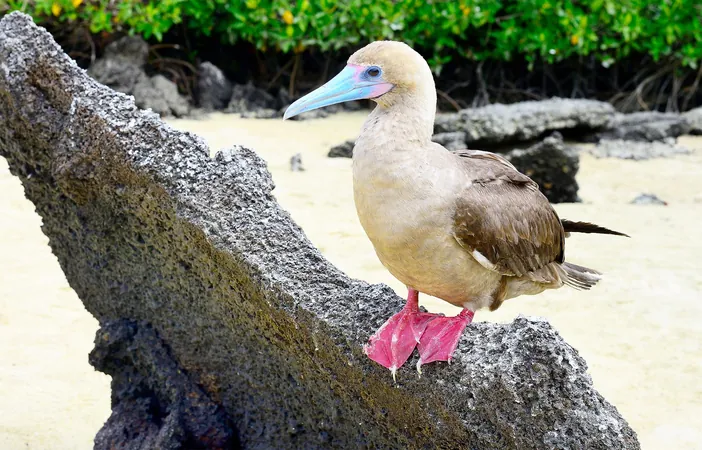
Soaring Skills: Red-Footed Boobies Caught in High-Flying Action with Tiny Cameras!
2025-08-08
Author: Nur
Unveiling the Secrets of Red-Footed Boobies
In a groundbreaking study, scientists have unveiled the thrilling aerial antics of red-footed boobies, showcasing their astonishing ability to snatch fish right from the air. These remarkable seabirds, hailing from the remote Chagos Archipelago of the Indian Ocean, have been filmed in action, confirming what many suspected: they can catch flying fish while soaring above the ocean.
Birds in Action: Capturing Aerial Feasts
Utilizing lightweight cameras strapped to two of the birds, researchers observed 15 attempts to capture prey—14 of which were breathtaking aerial pursuits, leaving only one as a diving attempt. Dr. Ruth Dunn from Heriot-Watt University, the study's lead author, notes the significance of these findings, stating, 'This is the first time we’ve recorded footage of them foraging and catching fish mid-air, which may indicate that a considerable part of their diet comes from this hunting method.'
Mastering Wind and Flight Dynamics
To understand their feeding habits better, scientists equipped an additional 18 red-footed boobies with GPS and accelerometer trackers, documenting 45 foraging trips. These birds typically embarked on journeys spanning hundreds of kilometers, revealing insights into their wind preferences. They thrive on flap-gliding, using a clever mix of flapping and gliding to maximize energy efficiency.
Harnessing Nature's Currents
The analysis unveiled a compelling relationship between wind direction and flight behavior. Boobies were seen flapping more vigorously against headwinds while gliding effortlessly with tailwinds, achieving an average speed of about 22 miles per hour. This wind savvy enables them to travel faster while conserving energy, a crucial asset for successful foraging.
Feeding Frenzy: How Wind Influences Catch Rates
Intriguingly, these seabirds show a stronger inclination to feed during windy conditions. The physics of wind aids flying fish in gliding longer distances, enhancing their visibility and making them easier targets. Similar trends have been noted by human fishers, who report increased catch rates during high winds.
Waves and Wind: The Perfect Hunting Combination
But it's not just wind—wave direction also plays a pivotal role in their hunting success. When waves align with their flight path, the likelihood of successful feeding rises. This interplay highlights the intricate relationship between seabirds and their marine environment, showcasing how adaptations to wind and wave patterns are vital for survival.
Facing a Changing Future
As climate change reshapes global wind patterns, these magnificent birds may face new challenges and opportunities. With predictions pointing to stronger storms and altered wind conditions, understanding these effects becomes crucial for forecasting how red-footed boobies will adapt.
Conservation in Focus: Protecting Feeding Grounds
This study underscores the importance of environmental factors in avian behavior, linking effective flight patterns to dietary success. As guardians of the ocean’s ecosystems, red-footed boobies rely on well-protected feeding zones, emphasizing the need for comprehensive marine conservation strategies. Protecting these habitats could secure the survival of these agile aerialists.
Stay Informed!
For more engrossing insights and the latest discoveries, don’t forget to subscribe to our newsletter!


 Brasil (PT)
Brasil (PT)
 Canada (EN)
Canada (EN)
 Chile (ES)
Chile (ES)
 Česko (CS)
Česko (CS)
 대한민국 (KO)
대한민국 (KO)
 España (ES)
España (ES)
 France (FR)
France (FR)
 Hong Kong (EN)
Hong Kong (EN)
 Italia (IT)
Italia (IT)
 日本 (JA)
日本 (JA)
 Magyarország (HU)
Magyarország (HU)
 Norge (NO)
Norge (NO)
 Polska (PL)
Polska (PL)
 Schweiz (DE)
Schweiz (DE)
 Singapore (EN)
Singapore (EN)
 Sverige (SV)
Sverige (SV)
 Suomi (FI)
Suomi (FI)
 Türkiye (TR)
Türkiye (TR)
 الإمارات العربية المتحدة (AR)
الإمارات العربية المتحدة (AR)